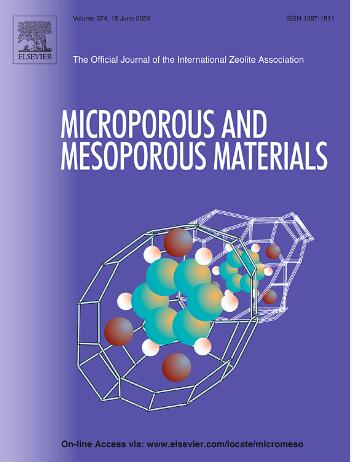Enhanced herbicide removal using an innovative NaP1-Fe3O4-La(OH)3 zeolite: Advances in water treatment and experimental modeling
IF 4.8
3区 材料科学
Q1 CHEMISTRY, APPLIED
引用次数: 0
Abstract
This study explores the synthesis of a novel and efficient NaP1 zeolite from Austrian fly ash (AFA), composited with Fe3O4 nanoparticles (NPs) and lanthanum hydroxides [La(OH)3]. The composite's efficacy was tested for simultaneously adsorbing glyphosate (GLY), glufosinate (Glu), and aminomethylphosphonic acid (AMPA) from water solution. The inclusion of Fe3O4 NPs and La(OH)3 enhanced the nanoadsorbent's rapid and effective separation capabilities. Significantly, an innovative kinetic model, the Film-Pore-[Concentration-Dependent] Surface Diffusion Model (FPCDSD), was developed to analyze adsorption mechanisms, aligning with experimental results and accurately predicting adsorption processes in single and competitive scenarios. The model used detailed calculations to evaluate mass transfer resistances, employing parameters like rotation speed, adsorbent dosage, and initial concentrations to correlate adsorption data under various conditions. The study found that adsorption capacity retained 92 % effectiveness after 10 adsorption-desorption cycles, consistent with previous research. Results indicated that electrostatic interactions, herbicide affinity for La and Fe complexes, hydrogen bonding, and surface and pore diffusion likely drive adsorption mechanisms. Laboratory tests showed that Gly achieved the Maximum Residual Level (MRL) of 0.1 μg/L as per the European directive for drinking water with 99.95 % removal efficiency, suggesting that NaP1-Fe3O4-La(OH)3 is a highly effective option for water treatment.

求助全文
约1分钟内获得全文
求助全文
来源期刊

Microporous and Mesoporous Materials
化学-材料科学:综合
CiteScore
10.70
自引率
5.80%
发文量
649
审稿时长
26 days
期刊介绍:
Microporous and Mesoporous Materials covers novel and significant aspects of porous solids classified as either microporous (pore size up to 2 nm) or mesoporous (pore size 2 to 50 nm). The porosity should have a specific impact on the material properties or application. Typical examples are zeolites and zeolite-like materials, pillared materials, clathrasils and clathrates, carbon molecular sieves, ordered mesoporous materials, organic/inorganic porous hybrid materials, or porous metal oxides. Both natural and synthetic porous materials are within the scope of the journal.
Topics which are particularly of interest include:
All aspects of natural microporous and mesoporous solids
The synthesis of crystalline or amorphous porous materials
The physico-chemical characterization of microporous and mesoporous solids, especially spectroscopic and microscopic
The modification of microporous and mesoporous solids, for example by ion exchange or solid-state reactions
All topics related to diffusion of mobile species in the pores of microporous and mesoporous materials
Adsorption (and other separation techniques) using microporous or mesoporous adsorbents
Catalysis by microporous and mesoporous materials
Host/guest interactions
Theoretical chemistry and modelling of host/guest interactions
All topics related to the application of microporous and mesoporous materials in industrial catalysis, separation technology, environmental protection, electrochemistry, membranes, sensors, optical devices, etc.
 求助内容:
求助内容: 应助结果提醒方式:
应助结果提醒方式:


